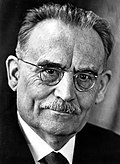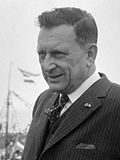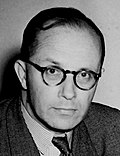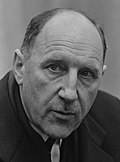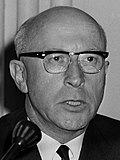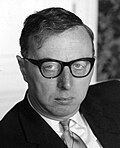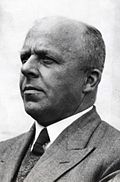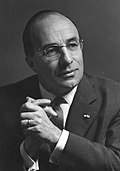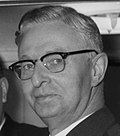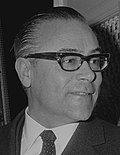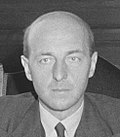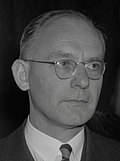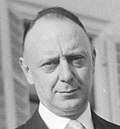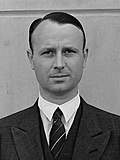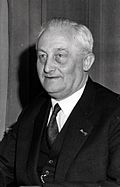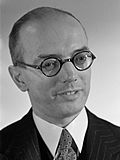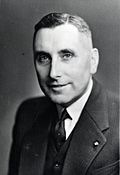Third Drees cabinet
Third Drees cabinet Fourth Drees cabinet | |
|---|---|
Cabinet of the Netherlands | |
  The first meeting of the incoming Third Drees cabinet on 12 October 1956 | |
| Date formed | 13 October 1956 |
| Date dissolved | 22 December 1958 2 years, 70 days in office (Demissionary from 11 December 1958) |
| People and organisations | |
| Monarch | Queen Juliana |
| Prime Minister | Willem Drees |
| Deputy Prime Minister | Teun Struycken |
| No. of ministers | 14 |
| Ministers removed | 2 |
| Total no. of members | 16 |
| Member party | Labour Party (PvdA) Catholic People's Party (KVP) Anti-Revolutionary Party (ARP) Christian Historical Union (CHU) |
| Status in legislature | Centre-left[1] Majority government (Grand coalition/Roman-Red) |
| History | |
| Election | 1956 election |
| Outgoing election | 1959 election |
| Legislature terms | 1956–1959 |
| Incoming formation | 1956 formation |
| Outgoing formation | 1958 formation |
| Predecessor | Second Drees cabinet |
| Successor | Second Beel cabinet |
| Part of the Politics series |
![Azure, billetty Or a lion with a coronet Or armed and langued Gules holding in his dexter paw a sword Argent hilted Or and in the sinister paw seven arrows Argent pointed and bound together Or. [The seven arrows stand for the seven provinces of the Union of Utrecht.] The shield is crowned with the (Dutch) royal crown and supported by two lions Or armed and langued gules. They stand on a scroll Azure with the text (Or) "Je Maintiendrai" (French for "I will maintain".)](/media/wikipedia/commons/thumb/8/8f/State_coat_of_arms_of_the_Netherlands.svg/150px-State_coat_of_arms_of_the_Netherlands.svg.png) |
|---|
|
|
The Third Drees cabinet, also called the Fourth Drees cabinet,[2] was the executive branch of the Dutch Government from 13 October 1956 until 22 December 1958. The cabinet was a continuation of the previous Second Drees cabinet and was formed by the social-democratic Labour Party (PvdA) and the christian-democratic Catholic People's Party (KVP), Anti-Revolutionary Party (ARP) and the Christian Historical Union (CHU) after the election of 1956. The cabinet was a Centre-left[3] grand coalition and had a substantial majority in the House of Representatives, with Labour Leader Willem Drees serving as Prime Minister. Prominent KVP politician Teun Struycken (a former Governor of the Netherlands Antilles) served as Deputy Prime Minister and Minister of the Interior, Property and Public Organisations.
The cabinet served during the middle years of the turbulent 1950s. Domestically, the recovery and rebuilding following World War II continued with the assistance of the Marshall Plan, it also able to finalize several major social reforms to social security, welfare, child benefits and education from the previous cabinet. Internationally the decolonization of the Dutch East Indies continued. After suffering several major internal and external conflicts, including multiple cabinet resignations, the cabinet fell two years into its term, on 11 December 1958, following a disagreement in the coalition over a proposed tax increase; the cabinet continued in a demissionary capacity until it was replaced with the caretaker Second Beel cabinet on 22 December 1958.[4]
Formation
[edit]The cabinet formation took four months. This was the longest and most difficult formation the Netherlands had ever seen, partly as a result of the rising tensions between the Labour Party and the Catholic People's Party. After the formation these tensions kept rising, leading to the fall of the cabinet in December 1958. The root of the tensions was the decision of the Roman Catholic Church to excommunicate Catholic socialists from the church. Nearly 100% of the south of the Netherlands used to vote for the Catholic People's Party for decades, but in the 1950s secular political parties got an increase in votes. The excommunication had the result of social exclusion in cities and villages which used to be solidly Catholic blocks. Protestants in the north supported the Catholics.
Term
[edit]After considerable growth after World War II, the rising wages, combined with lowered taxes, now led to overspending, which endangered the export. In reaction, wages and government spending were both lowered.
Rising tension with Indonesia, mostly about New Guinea, came to a climax when Indonesia nationalised Dutch properties in the country. The Dutch were supposed to leave entirely.
Other international problems were the Suez Crisis and the Hungarian revolt, which led to monetary and economic problems. The threat of an oil crisis as a result of the Suez crisis led to the installation of car-free Sundays. The suppression of the Hungarian revolution by the USSR led to plundering of communist institutions. Several thousands of Hungarian refugees were accepted into the Netherlands and welcomed in Dutch homes.
On 1 January 1957, the state pension AOW after the age of 65, that was proposed during the former cabinet Drees II, was installed. This resulted from a previous emergency law by Drees, and is the one thing he is remembered for most.



Cabinet members
[edit]- Resigned
- Retained from the previous cabinet
- Continued in the next cabinet
- Acting
- Ad Interim
- Appointed as Member of the Council of State
- Appointed as European Commissioner
Trivia
[edit]- Eight cabinet members had previous experience as scholars and professors: Henk Hofstra (Fiscal Law), Ivo Samkalden (Agricultural Law), Jelle Zijlstra (Public Economics), Anne Vondeling (Agronomy and Agricultural Engineering), Marga Klompé (Chemistry), Gerard Veldkamp (Microeconomics), Aat van Rhijn (Fiscal Law) and Anna de Waal (Geography).
- Five cabinet members would later be granted the honorary title of Minister of State: Willem Drees (1958), Ivo Samkalden (1985), Jelle Zijlstra (1983), Jo Cals (1966) and Marga Klompé (1971).
- Four cabinet members (later) served as Party Leaders and Lijsttrekkers: Willem Drees (1946–1946) of the Social Democratic Workers' Party and (1946–1958) of the Labour Party, Anne Vondeling (1962–1966) of the Labour Party, Jelle Zijlstra (1956, 1958–1959) of the Anti-Revolutionary Party and Norbert Schmelzer (1963–1971) of the Catholic People's Party.
- Two cabinet members lived to centenarian age: Willem Drees (1886–1988) lived to 101 years, 314 days and Gerard Helders (1905–2013) lived to 107 years, 303 days.
References
[edit]- ^ Changing Liaisons The Dynamics of Social Partnership in 20th Century West-European DemocraciesBy Karel Davids, 2007, P.165
- ^ According to a different numbering this was the Fourth Drees cabinet because it was the fourth cabinet with Willem Drees as Prime Minister.
- ^ Changing Liaisons The Dynamics of Social Partnership in 20th Century West-European DemocraciesBy Karel Davids, 2007, P.165
- ^ "Coalities tussen sociaaldemocraten en confessionelen" (in Dutch). Historisch Nieuwsblad. 10 August 2006. Retrieved 24 April 2018.
External links
[edit]- Official
- (in Dutch) Kabinet-Drees IV Parlement & Politiek
- (in Dutch) Kabinet-Drees III Rijksoverheid

